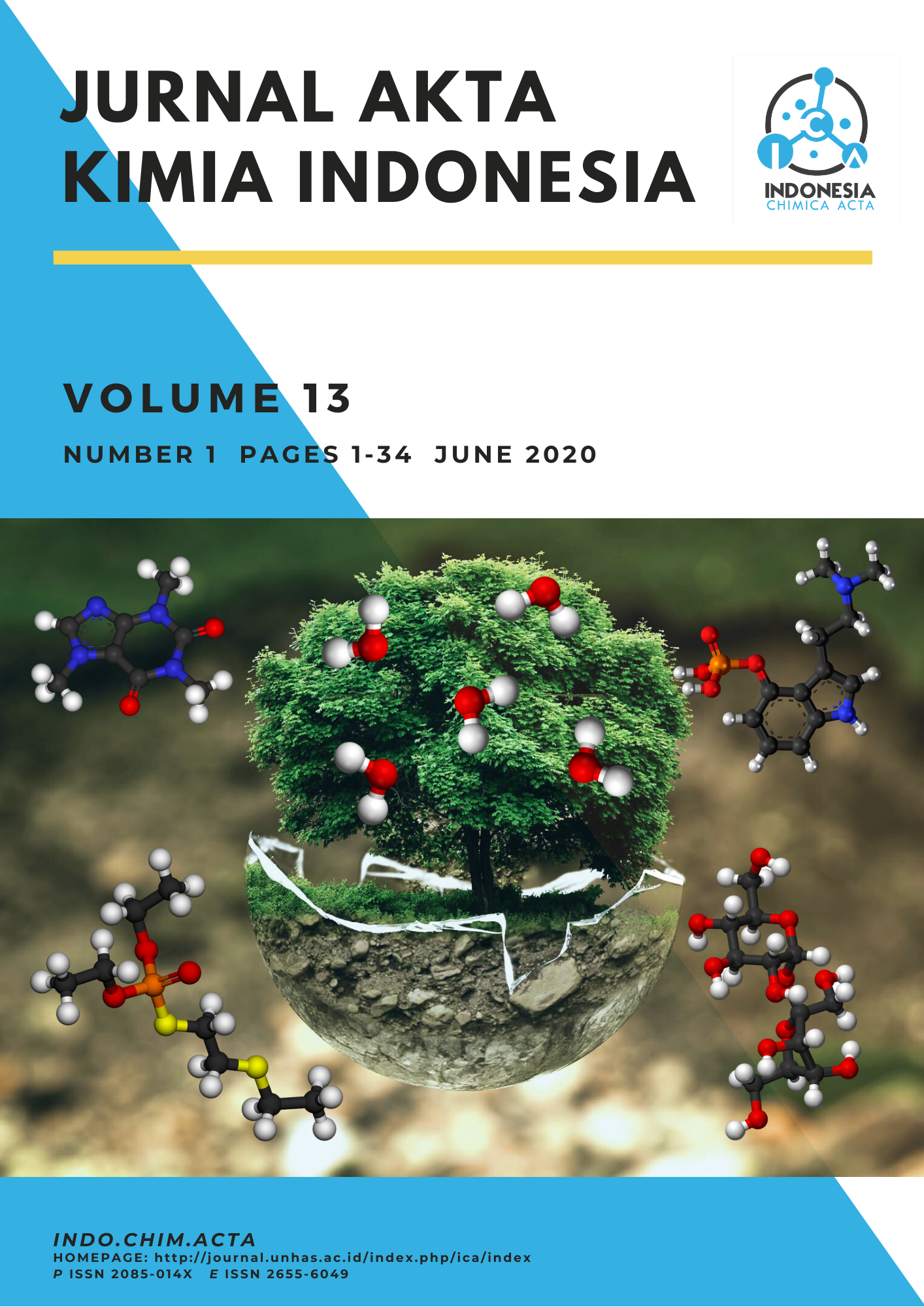The Bio-Adsorption Pattern Bacteria Symbiont Sponge Marine Against Contaminants Chromium and Manganese In The Waste Modification of Laboratory Scale
Abstract
References
Agarwal, C., & Bagla, P. . (2013). Biocidal Effects of Cu(II) and Ni(II) Complexes of Schipp Base From Coumarin Moeity. Asian Journal of Chemical and Envirimental Research, 6(3), 105–109.
Alaboudi, K. A., Ahmed, B., & Brodie, G. (2018). Annals of Agricultural Sciences Phytoremediation of Pb and Cd contaminated soils by using sun fl ower ( Helianthus annuus ) plant. Annals of Agricultural Sciences, 63(1), 123–127. https://doi.org/10. 1016/j.aoas.2018.05.007
Alimardan, M., Ziarati, P., & Moghadam, R. J. (2016). Adsorption of Heavy Metal Ions from Contaminated Soil by B. integerrima Barberry Adsorption of Heavy Metal Ions from Contaminated Soil by B . integerrima Barberry. Biomedical & Pharmacology Journal, 9(1), 1–7. https://doi.org/10.13005/bpj/924
Bibi, F., Faheem, M., Azhar, E. I., Yasir, M., Alvi, S. A., Kamal, M. A., … Nasser, M. I. (2016). Bacteria From Marine Sponges : A Source of New Drugs Bacteria From Marine Sponges : A Source of New Drugs. Current Drug Metabolism, 17(October), 1–6. https://doi.org/10. 2174/13892002176661610130906
De Rosa, S., Iodice, C., Nechev, J., Stefanov, K., & Popov, S. (2003). Composition of the lipophilic extract from the sponge Suberites domuncula. Journal of the Serbian Chemical Society, 68(4–5), 249–256.
Karimpour, M., & Davoud, S. (2018). Adsorption of cadmium and lead onto live and dead cell mass of Pseudomonas aeruginosa : A dataset. Elsevier, 18, 1185–1192. https://doi. org/10.1016/j.dib.2018.04.014
Konkolewska, A., Piechalak, A., Ciszewska, L., Antos-krzemi, N., & Skrzypczak, T. (2020). Combined use of companion planting and PGPR for the assisted phytoextraction of trace metals ( Zn , Pb , Cd ). Environmental Science and Pollution Research, (Februari).
Marzuki, I. (2016). Analisis Chromium Hexavalent dan Nikel Terlarut dalam Limbah Cair Area Pertambangan PT VALE Tbk . Soroako-Indonesia Analysis of Hexavalent Chromium and Dissolved Nickel in Water Waste Used in Mining Area of PT VALE Tbk . Soroako-Indonesia. Jurnal Chemica, 1(2), 1–11. https://doi.org /10.17605/OSF .IO/YF9QJ
Marzuki, I., Alwi, R. S., Erniati, Mudyawati, Sinardi, & Iryani, A. S. (2019a). Chitosan Performance of Shrimp Shells in The Biosorption Ion Metal of Cadmium, Lead and Nickel Based on Variations pH Interaction. Atlantik Press, 165(1), 6–11. https://doi.org/10.2991/icmeme-18.2 019.2
Marzuki, I., Ashari, M. I., M, A. A. M., & Angela, A. (2019b). Aplikasi Mikrosimbions Spons Laut Sebagai Biomaterial Pereduksi Toksisitas Logam Berat Kromium. Al-Kimia, 7(1), 67–75. https://doi.org/ 10.24252/al-kimia.v7i1.7388
Marzuki, I., Noor, A., Nafie, N. La, & Djide, M. N. (2016). Morphological and phenotype analysis of microsymbiont and biomass marine sponge from melawai beach, balikpapan, east kalimantan. International Journal Marina Chimic Acta, 17(1), 8–15.
Marzuki, I., Sinardi, Asmeati, & Yunus, S. (2019c). Aplikasi Mikrosimbion spons laut sebagai material dalam metode bioremediasi toksisitas logam berat. In Prosiding Seminar Nasional Penelitian & Pengabdian Kepada Masyaraka (Vol. 2019, pp. 1–6).
Melawaty, L., Noor, A., Harlim, T., & de Voogd, N. (2014). Essential metal Zn in sponge Callyspongia aerizusa from Spermonde Archipelago. Advances in Biological Chemistry, 04(01), 86–90. https://doi.org/10.4236/abc.20 14.41012
Naghipour, D., & Davoud, S. (2018). Data in Brief Phytoremediation of heavy metals ( Ni , Cd , Pb ) by Azolla fi liculoides from aqueous solution : A dataset. Journal Data in Brief, 21, 1409–1414. https://doi.org/10.1016/j. dib.2018.10.111
Orani, A. M., Barats, A., Vassileva, E., & Thomas, O. P. (2018). Marine sponges as a powerful tool for trace elements biomonitoring studies in coastal environment. Marine Pollution Bulletin, 131(April), 633–645. https://doi.org/10.1016/j. marpolbul.2018. 04.073
Pawar, P. R. (2017). Assessment of microbial diversity in marine waters along the Uran coastal area of Navi Mumbai,. Advances in Environmental Biology, 11(August), 11–24.
Riyaz, P. P. S. M., Sai, G. M., Natarajan, P., & Chandran, P. (2020). Experimental Investigation of Chromium and Nickel Thin Sheets on EN8 Steel by Plating Technique. International Journal of Scientific Research and Engineering Development, 3(2), 509–516.
Sharma, G., Sunder, S., Adhikari, S., & Rohanifar, A. (2020). Evolution of Environmentally Friendly Strategies for Metal Extraction. Separations Journal, 7(4), 1–27.
Wibowo, N., Nurcahyo, R., & Gabriel, D. S. (2019). Sponge Iron Plant Feasibility Studi in Kalimantan, Indonesia. ARPN Journal of Engineering and Applied Sciences, 14(23), 4013–4020.
Yang, Q., Franco, C. M. M., Lin, H. W., & Zhang, W. (2019). Untapped sponge microbiomes: Structure specificity at host order and family levels. FEMS Microbiology Ecology, 95(9). https: //doi.org/10.1093/femsec/fiz136
Zahirnejad, M., Ziarati, P., & Asgarpanah, J. (2017). The Efficiency of Bio-adsorption of Heavy Metals from Pharmaceutical Effluent by Rumex Original Article The Efficiency of Bio-adsorption of Heavy Metals from Pharmaceutical Effluent by Rumex crispus L. Seed. Journal of Pharmaceutical and Health Sciences, 5(3), 231–243.
Ziarati, P., Ziarati, N. N., Nazeri, S., & Saber-Germi, M. (2015). Phytoextraction of heavy metals by two sorghum spices in treated soil using black tea residue for cleaning-uo the contaminated soil. Oriental Journal of Chemistry, 31(1), 317–326. https://doi.org/10.13005/ojc/ 310136
Authors
This is an open access journal which means that all contents is freely available without charge to the user or his/her institution. Users are allowed to read, download, copy, distribute, print, search, or link to the full texts of the articles in this journal without asking prior permission from the publisher or the author.
Jurnal Akta Kimia Indonesia (Indonesia Chimica Acta) operates a CC BY-SA 4.0 © license for journal papers. Copyright remains with the author, but Jurnal Akta Kimia Indonesia (Indonesia Chimica Acta) is licensed to publish the paper, and the author agrees to make the article available with the CC BY-SA 4.0 license. Reproduction as another journal article in whole or in part would be plagiarism. Jurnal Akta Kimia Indonesia (Indonesia Chimica Acta) reserves all rights except those granted in this copyright notice.

